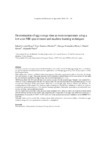Mostrar o rexistro simple do ítem
Determination of Egg Storage Time at Room Temperature Using a Low-Cost NIR Spectrometer and Machine Learning Techniques
| dc.contributor.author | Coronel-Reyes, Julián | |
| dc.contributor.author | Ramírez-Morales, Iván | |
| dc.contributor.author | Fernández-Blanco, Enrique | |
| dc.contributor.author | Rivero, Daniel | |
| dc.contributor.author | Pazos, A. | |
| dc.date.accessioned | 2019-02-14T09:21:21Z | |
| dc.date.issued | 2017-12-21 | |
| dc.identifier.citation | Coronel-Reyes J, Ramírez-Morales I, Fernández-Blanco E, et al. Determination of egg storage time at room temperature using a low-cost NIR spectrometer and machine learning techniques. Comput Electron Agric. 2018; 145: 1-10 | es_ES |
| dc.identifier.issn | 0168-1699 | |
| dc.identifier.uri | http://hdl.handle.net/2183/21737 | |
| dc.description.abstract | [Abstract] Currently, consumers are more concerned about freshness and quality of food. Poultry egg storage time is a freshness and quality indicator in industrial and consumer applications, even though egg marking is not always required outside the European Union. Other authors have already published works using expensive laboratory equipment in order to determine the storage time and freshness of eggs. This paper presents a novel alternative method based on low-cost devices for the rapid and non-destructive prediction of egg storage time at room temperature (23 ± 1 °C). H&N brown flock with 49-week-old hens were used as a source for the sampled eggs. Samples were scanned for a period of 22 days beginning from the time the egg was laid. The spectral acquisition was performed using a low-cost near-infrared reflectance (NIR) spectrometer which has a wavelength range between 740 nm and 1070 nm. The resulting dataset of 660 samples was randomly split according to a 10-fold cross-validation in order to be used in a contrast and optimization process of two machine learning algorithms. During the optimization, several models were tested to develop a robust calibration model. The best model used a Savitzky Golay pre-processing technique with a third derivative order and an artificial neural network with ten neurons in one hidden layer. Regressing the storage time of the eggs, tests achieved a coefficient of determination (R-squared) of 0.8319 ± 0.0377 and a root mean squared error in cross-validation test set (RMSECV) of 1.97 days. Although further work is needed, this technique shows industrial potential and consumer utility to determine an egg's freshness using a low-cost spectrometer connected to a smartphone. | es_ES |
| dc.language.iso | eng | es_ES |
| dc.publisher | Elsevier | es_ES |
| dc.relation.uri | https://doi.org/10.1016/j.compag.2017.12.030 | es_ES |
| dc.rights | Atribución-NoComercial-SinDerivadas 3.0 España | es_ES |
| dc.rights.uri | http://creativecommons.org/licenses/by-nc-nd/3.0/es/ | * |
| dc.subject | Non-destructive | es_ES |
| dc.subject | Chemometrics | es_ES |
| dc.subject | Freshness | es_ES |
| dc.subject | Poultry | es_ES |
| dc.subject | Neural networks | es_ES |
| dc.title | Determination of Egg Storage Time at Room Temperature Using a Low-Cost NIR Spectrometer and Machine Learning Techniques | es_ES |
| dc.type | info:eu-repo/semantics/article | es_ES |
| dc.rights.access | info:eu-repo/semantics/embargoedAccess | es_ES |
| dc.date.embargoEndDate | 2019-12-21 | es_ES |
| dc.date.embargoLift | 2019-12-21 | |
| UDC.journalTitle | Computers and Electronics in Agriculture | es_ES |
| UDC.volume | 145 | es_ES |
| UDC.startPage | 1 | es_ES |
| UDC.endPage | 10 | es_ES |
Ficheiros no ítem
Este ítem aparece na(s) seguinte(s) colección(s)
-
GI-RNASA - Artigos [193]






